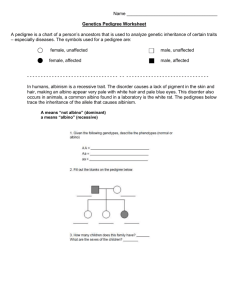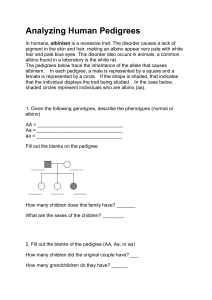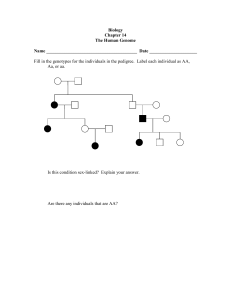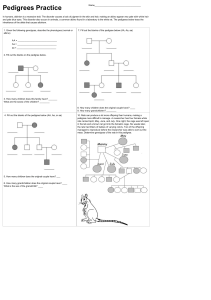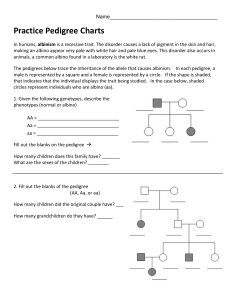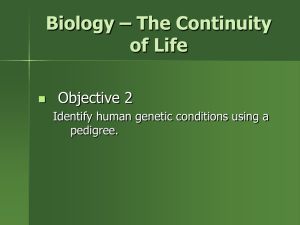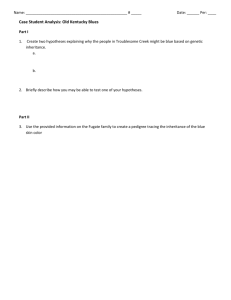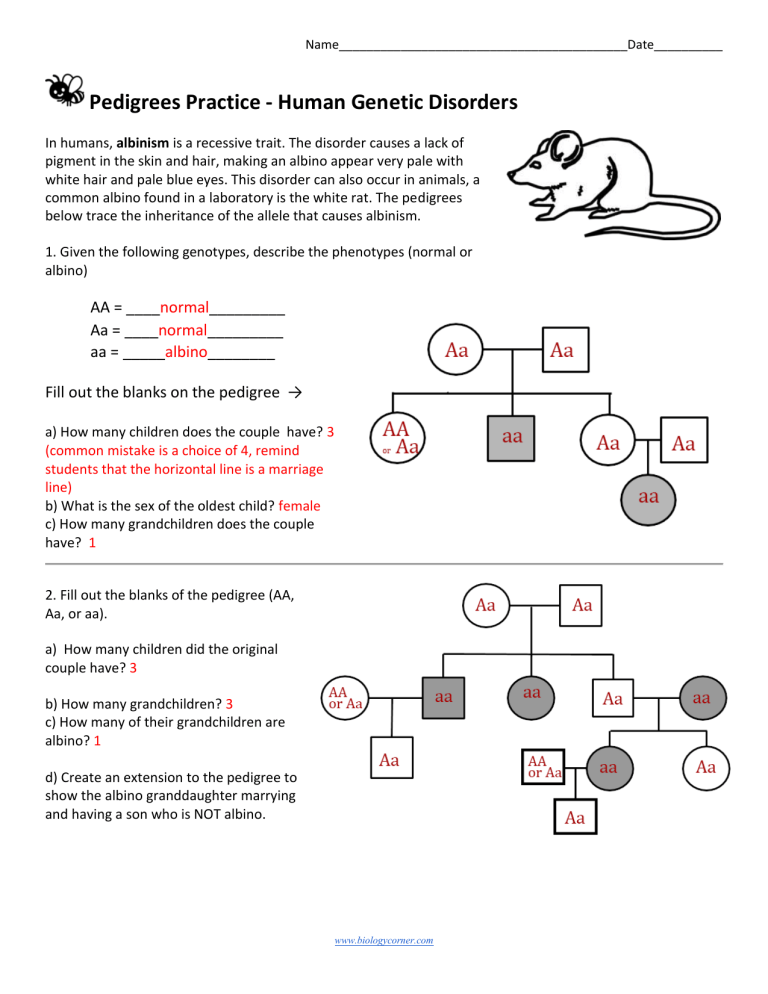
Name__________________________________________Date__________ Pedigrees Practice - Human Genetic Disorders In humans, albinism is a recessive trait. The disorder causes a lack of pigment in the skin and hair, making an albino appear very pale with white hair and pale blue eyes. This disorder can also occur in animals, a common albino found in a laboratory is the white rat. The pedigrees below trace the inheritance of the allele that causes albinism. 1. Given the following genotypes, describe the phenotypes (normal or albino) AA = ____normal_________ Aa = ____normal_________ aa = _____albino________ Fill out the blanks on the pedigree → a) How many children does the couple have? 3 (common mistake is a choice of 4, remind students that the horizontal line is a marriage line) b) What is the sex of the oldest child? female c) How many grandchildren does the couple have? 1 2. Fill out the blanks of the pedigree (AA, Aa, or aa). a) How many children did the original couple have? 3 b) How many grandchildren? 3 c) How many of their grandchildren are albino? 1 d) Create an extension to the pedigree to show the albino granddaughter marrying and having a son who is NOT albino. www.biologycorner.com 3. This pedigree shows the inheritance of Tay-Sachs in a family. Tay-Sachs is a recessive disorder that causes cells to be unable to break down waste products. These wastes build up in brain cells and cause damage and eventual death. Fill out the genotypes of each of the family members. TT = normal Tt = carrier tt = disease 4. This pedigree shows the inheritance of cystic fibrosis in a family. This disease causes mucus to build up in the lungs, leading to breathing difficulty and infections FF = ____normal________ Ff = _____normal_________ ff = ____cystic fibrosis______ Fill out the genotypes of each of the family members. Add to the chart to show the youngest male (4th) generation marrying and having a child with CF. 5. This pedigree shows the inheritance of sickle cell disease (recessive). Fill out the genotypes of the family. AA = normal Aa = carrier aa = sickle cell disease www.biologycorner.com Name__________________________________________Date__________ Pedigrees Practice - Human Genetic Disorders In humans, albinism is a recessive trait. The disorder causes a lack of pigment in the skin and hair, making an albino appear very pale with white hair and pale blue eyes. This disorder can also occur in animals, a common albino found in a laboratory is the white rat. The pedigrees below trace the inheritance of the allele that causes albinism. 1. Given the following genotypes, describe the phenotypes (normal or albino) AA = __________________________ Aa = _________________________ aa = __________________________ Fill out the blanks on the pedigree → a) How many children does the couple have? b) What is the sex of the oldest child? c) How many grandchildren does the couple have? 2. Fill out the blanks of the pedigree (AA, Aa, or aa). a) How many children did the original couple have? b) How many grandchildren? c) How many of their grandchildren are albino? d) Create an extension to the pedigree to show the albino granddaughter marrying and having a son who is NOT albino. www.biologycorner.com 3. This pedigree shows the inheritance of Tay-Sachs in a family. Tay-Sachs is a recessive disorder that causes cells to be unable to break down waste products. These wastes build up in brain cells and cause damage and eventual death. Fill out the genotypes of each of the family members. TT = normal Tt = carrier tt = disease 4. This pedigree shows the inheritance of cystic fibrosis in a family. This disease causes mucus to build up in the lungs, leading to breathing difficulty and infections FF = ___________________ Ff = ____________________ ff ____________________ = Fill out the genotypes of each of the family members. Add to the chart to show the youngest male (4th) generation marrying and having a child with CF. 5. This pedigree shows the inheritance of sickle cell disease (recessive). Fill out the genotypes of the family. AA = normal Aa = carrier aa = sickle cell disease www.biologycorner.com www.biologycorner.com
